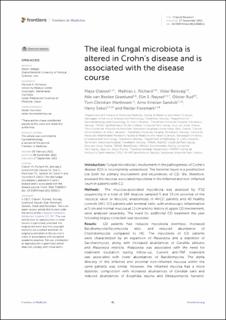| dc.contributor.author | Olaisen, Maya | |
| dc.contributor.author | Richard, Mathias L. | |
| dc.contributor.author | Beisvag, Vidar | |
| dc.contributor.author | Granlund, Atle van Beelen | |
| dc.contributor.author | Røyset, Elin Synnøve | |
| dc.contributor.author | Rué, Olivier | |
| dc.contributor.author | Martinsen, Tom Christian | |
| dc.contributor.author | Sandvik, Arne Kristian | |
| dc.contributor.author | Sokol, Harry | |
| dc.contributor.author | Fossmark, Reidar | |
| dc.date.accessioned | 2023-01-31T10:22:13Z | |
| dc.date.available | 2023-01-31T10:22:13Z | |
| dc.date.created | 2022-10-24T13:30:51Z | |
| dc.date.issued | 2022 | |
| dc.identifier.citation | Frontiers in medicine. 2022, 9 . | en_US |
| dc.identifier.issn | 2296-858X | |
| dc.identifier.uri | https://hdl.handle.net/11250/3047328 | |
| dc.description.abstract | Introduction: Fungal microbiota's involvement in the pathogenesis of Crohn's disease (CD) is incompletely understood. The terminal ileum is a predilection site both for primary involvement and recurrences of CD. We, therefore, assessed the mucosa-associated mycobiota in the inflamed and non-inflamed ileum in patients with CD.
Methods: The mucosa-associated mycobiota was assessed by ITS2 sequencing in a total of 168 biopsies sampled 5 and 15 cm proximal of the ileocecal valve or ileocolic anastomosis in 44 CD patients and 40 healthy controls (HC). CD patients with terminal ileitis, with endoscopic inflammation at 5 cm and normal mucosa at 15 cm and no history of upper CD involvement, were analyzed separately. The need for additional CD treatment the year following biopsy collection was recorded.
Results: CD patients had reduced mycobiota evenness, increased Basidiomycota/Ascomycota ratio, and reduced abundance of Chytridiomycota compared to HC. The mycobiota of CD patients were characterized by an expansion of Malassezia and a depletion of Saccharomyces, along with increased abundances of Candida albicans and Malassezia restricta. Malassezia was associated with the need for treatment escalation during follow-up. Current anti-TNF treatment was associated with lower abundances of Basidiomycota. The alpha diversity of the inflamed and proximal non-inflamed mucosa within the same patients was similar. However, the inflamed mucosa had a more dysbiotic composition with increased abundances of Candida sake and reduced abundances of Exophiala equina and Debaryomyces hansenii.
Conclusions: The ileal mucosa-associated mycobiota in CD patients is altered compared to HC. The mycobiota in the inflamed and proximal non-inflamed ileum within the same patients harbor structural differences which may play a role in the CD pathogenesis. Increased abundance of Malassezia was associated with an unfavorable disease course. | en_US |
| dc.language.iso | eng | en_US |
| dc.publisher | Frontiers Media | en_US |
| dc.rights | Navngivelse 4.0 Internasjonal | * |
| dc.rights.uri | http://creativecommons.org/licenses/by/4.0/deed.no | * |
| dc.title | The ileal fungal microbiota is altered in Crohn's disease and is associated with the disease course | en_US |
| dc.title.alternative | The ileal fungal microbiota is altered in Crohn's disease and is associated with the disease course | en_US |
| dc.type | Peer reviewed | en_US |
| dc.type | Journal article | en_US |
| dc.description.version | publishedVersion | en_US |
| dc.source.pagenumber | 16 | en_US |
| dc.source.volume | 9 | en_US |
| dc.source.journal | Frontiers in medicine | en_US |
| dc.identifier.doi | 10.3389/fmed.2022.868812 | |
| dc.identifier.cristin | 2064427 | |
| dc.relation.project | Norges forskningsråd: 223255 | en_US |
| cristin.ispublished | true | |
| cristin.fulltext | original | |
| cristin.qualitycode | 1 | |

